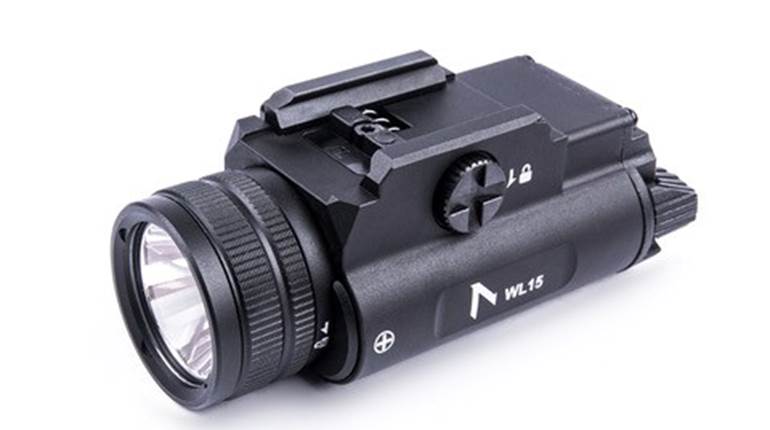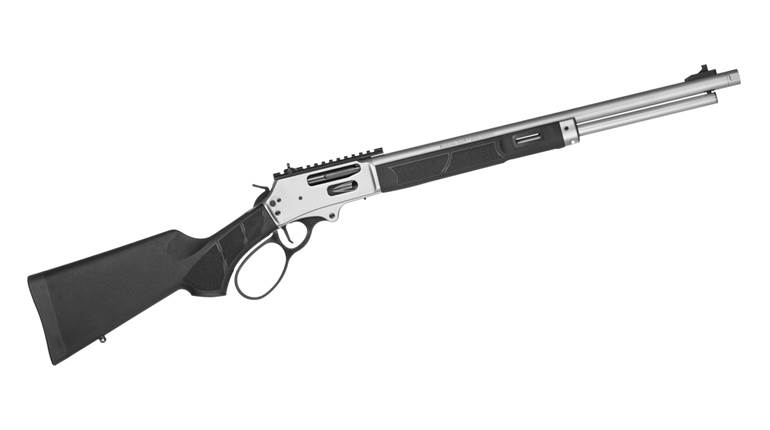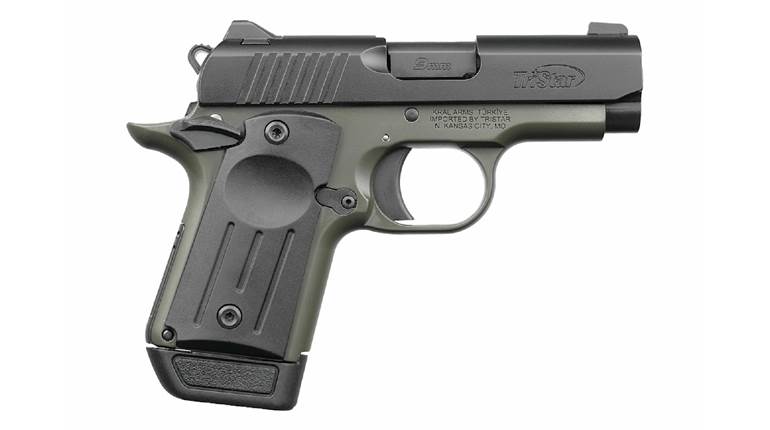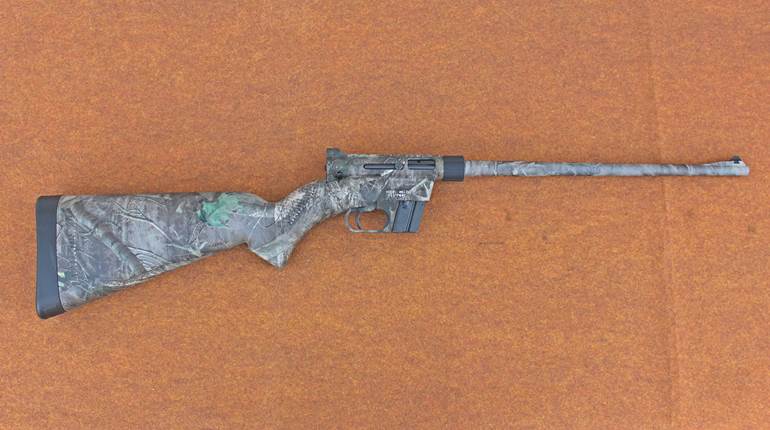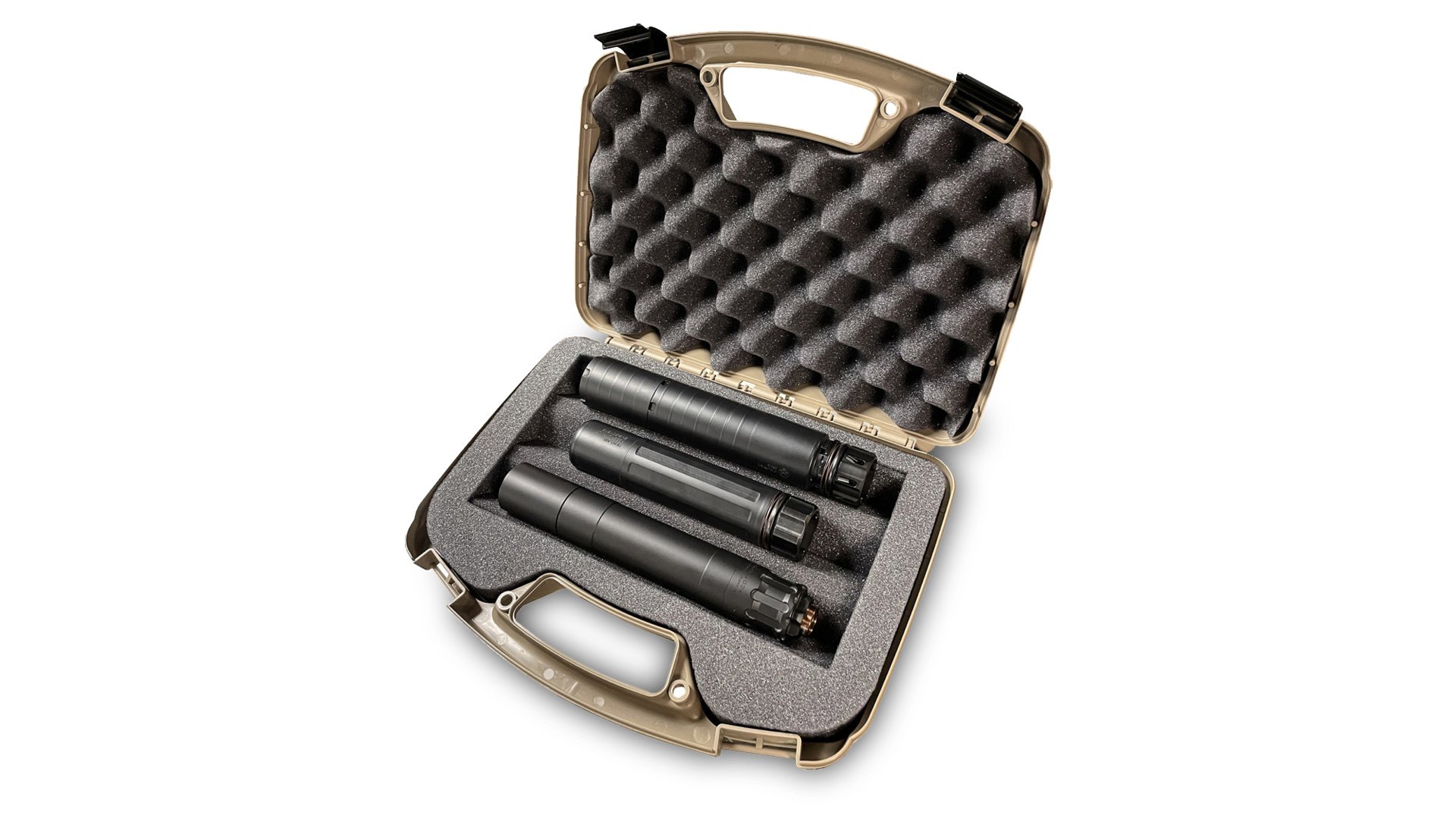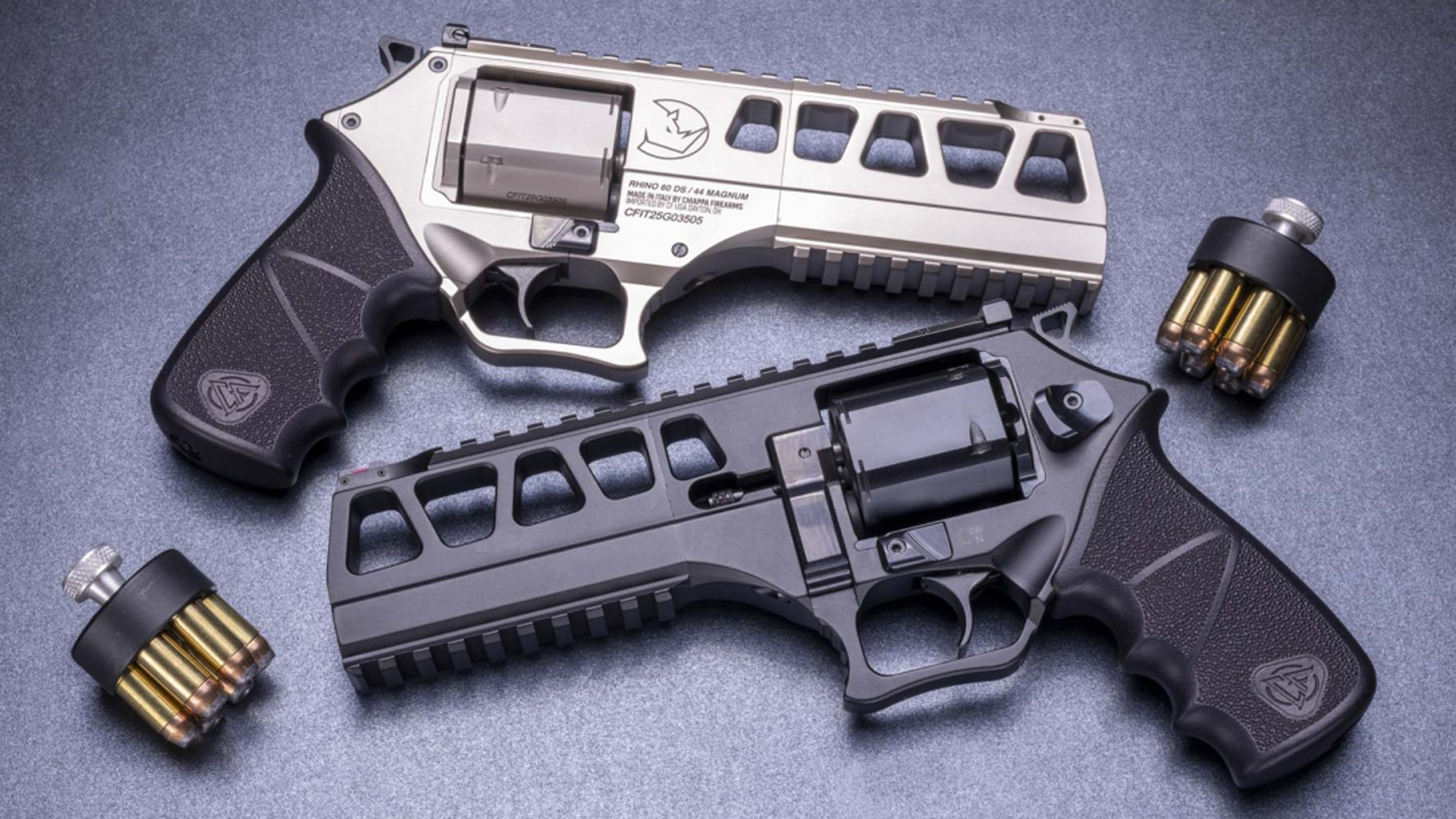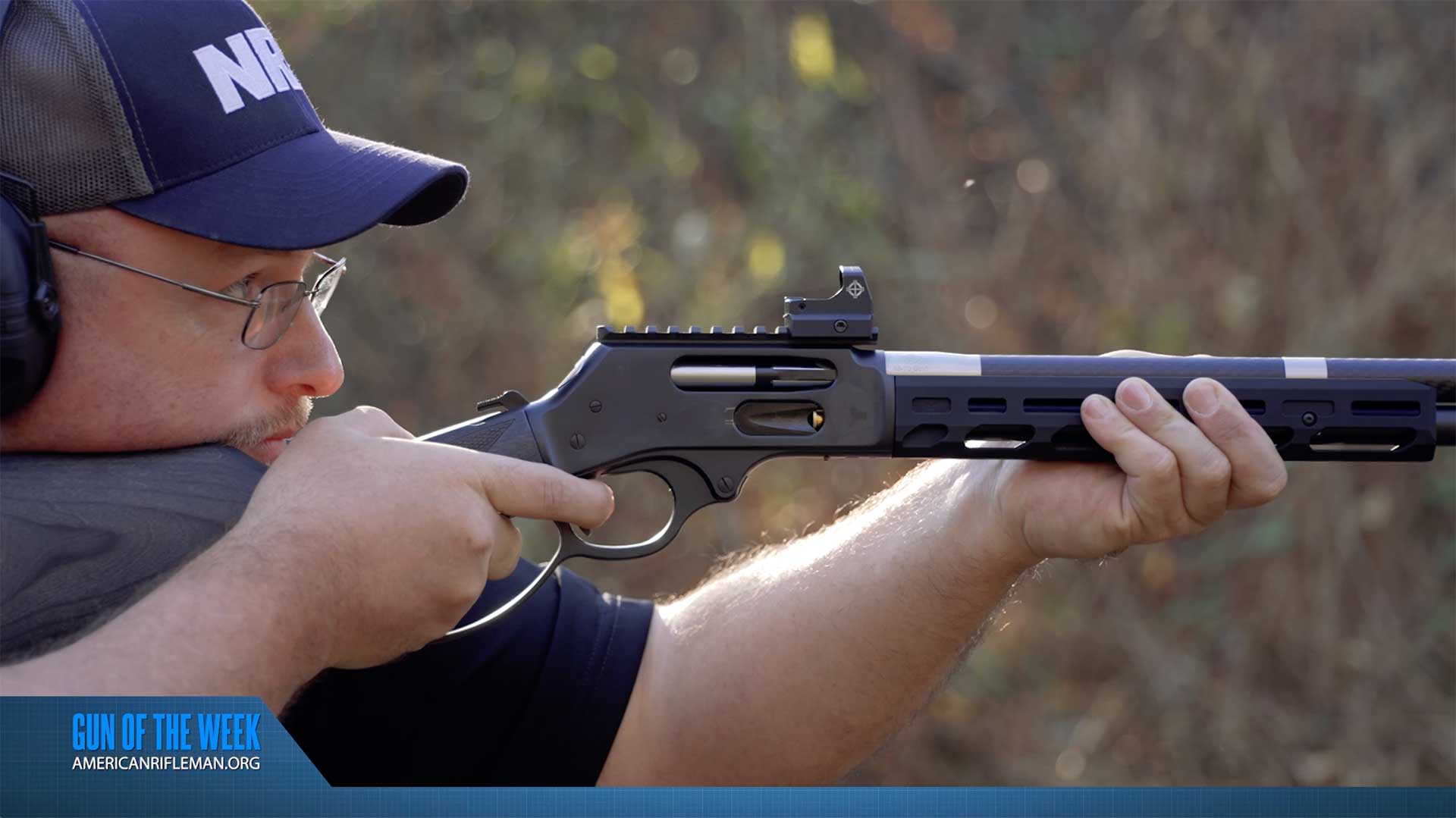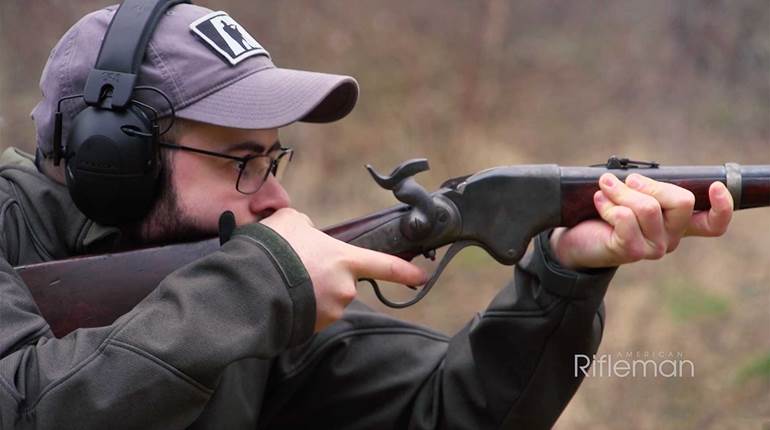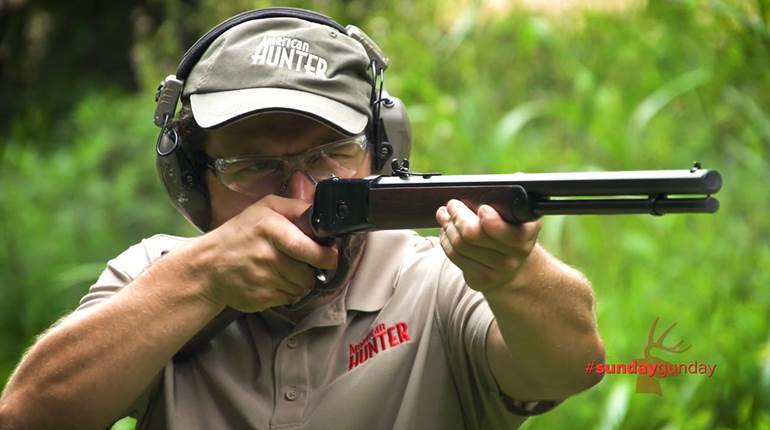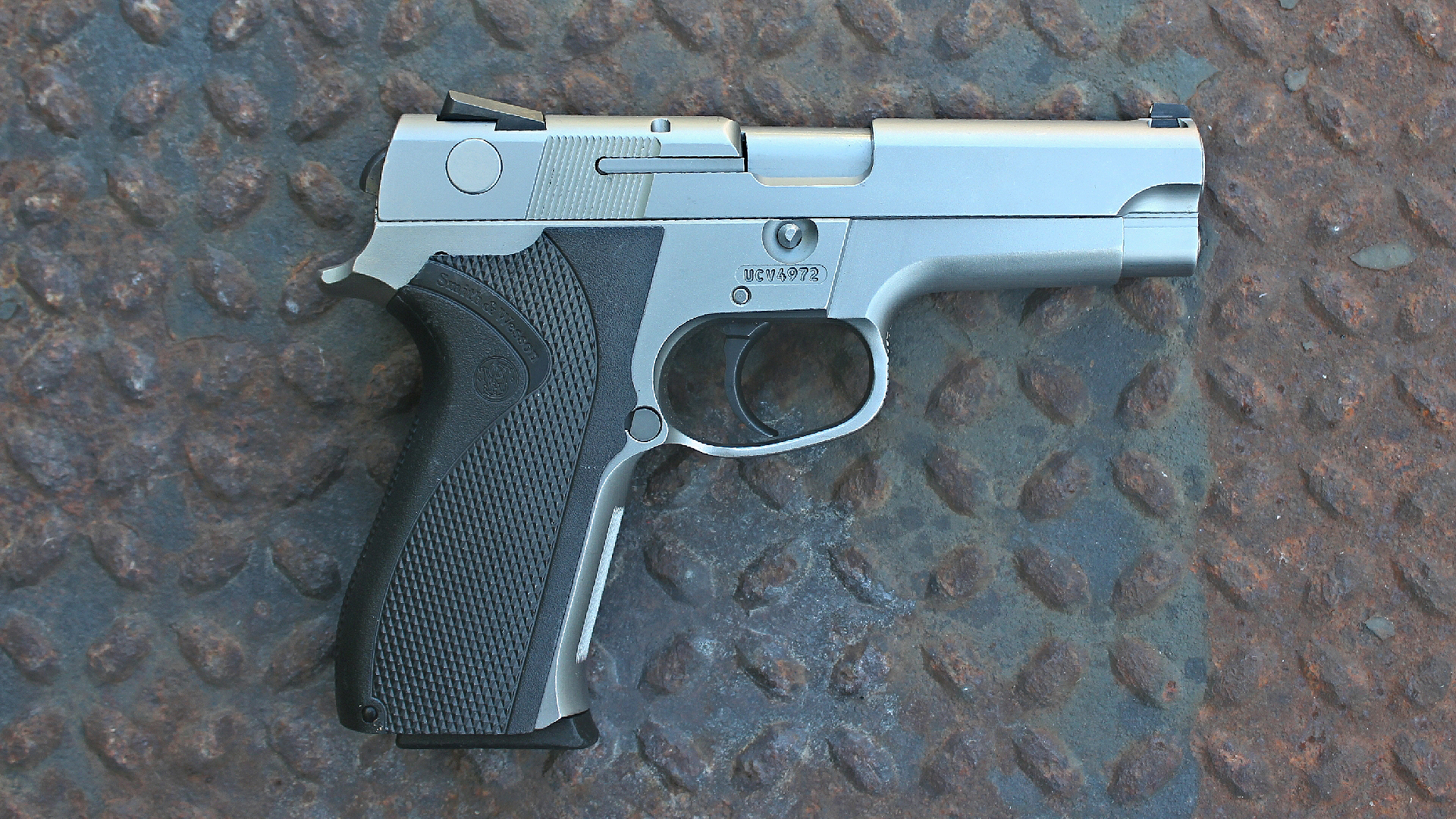
Among the many interesting facets of handgun development history are those examples that could be called the transitional models. These include older guns modified to make them compatible with emergent technologies, or newer models with features intended to suit the tastes of old-fashioned shooters. A good example of the latter are the now sometimes forgotten double-action only (DAO) law enforcement duty pistols like the Smith & Wesson 5946, which is the subject of this evaluation.
In the late 1980s and early 1990s, both state and federal law enforcement agencies were in the process of trading out their officers’ .38 Spl. and .357 Mag. revolvers for the then up-and-coming 'Wonder Nine' duty guns. These were the 9 mm Luger-chambered semi-automatic pistols configured for double-stack capacity magazines. But there were those in uniform who were not all that thrilled with this change.
 Made specifically for law enforcement, the Model 5046 was manufactured from 1990 to 1999.
Made specifically for law enforcement, the Model 5046 was manufactured from 1990 to 1999.
Some officers who had been qualifying with and carrying double-action revolvers for 20 or 30 years didn't care about the increased ammunition capacity. They didn't like the idea of a sidearm that required the added step of switching off a thumb safety in order to fire. They were also not too keen on having to manage a double-action/single-action (DA/SA) trigger pull that changed, depending on the position of the hammer. Instead, they wanted to stick with a trigger that had the same feel and pull weight for every shot fired. This is where the double-action only semi-automatics like the Smith & Wesson Model 5946 came into play.
 This pistol is topped with a set of Novak Lo-Mount three-dot sights.
This pistol is topped with a set of Novak Lo-Mount three-dot sights.
In the past, I've found law enforcement trade-in guns to be a great bargain for the more casual gun collectors, shooting sports eclectics and for those looking for more affordable used handguns suitable for self defense. AIM Surplus provided some of these guns for review, including a retired SIG Sauer P226 and Glock Gen 2 G22.
Recently, I learned that AIM had received some Model 5946 pistols which were in top-notch condition. Configured specifically for law enforcement agencies, they were manufactured from 1990 to 1999. Because DAO pistols were something of a black sheep among the single-action and DA/SA pistol fans of the time, they are not nearly as common as other Smith & Wesson 5900 series pistols. This opportunity to work with a transitional DAO pistol was too good to pass up, so I requested one for evaluation.
 The rounded hammer spur serves as a cocked-hammer indicator.
The rounded hammer spur serves as a cocked-hammer indicator.
As a member of the 3rd Generation of the 5900 series of semi-automatic pistols, the short-recoil operated, locked-breech Model 5946 is part of a rich production history. Its design is rooted in the 1st Generation Model 39, a blued steel, single-stack 9 mm released in 1954. Folks would have to wait until 1971 for the release of the Model 59, which sported a 14-round double-stack magazine. The 2nd Generation 9 mm pistols were manufactured from 1979 to 1988. They are distinguished from their predecessors with three-digit model numbers, including the single-stack 9 mm 439, the double-stack 459 9 mm and the single-stack .45 ACP 645 series.
By 1988, Smith & Wesson was ready to launch its 3rd Generation models, which would remain in production until 2010. The catalog would expand to include more than 60 individual models in various sizes and calibers. The lineup was broken out into six subsets using a four-digit model numbering system that needs some decoding to make sense. The first two digits of the model number indicate the caliber and, in the case of the 9 mm pistols, the magazine capacity. The third digit indicates the pistol's size and action type and the fourth represents the metals used and the finish.
 The rounded trigger guard is checkered along the front edge and undercut where it meets the grip frame.
The rounded trigger guard is checkered along the front edge and undercut where it meets the grip frame.
The "59" in the Model 5946 number indicates a double-stack capacity 9 mm. In this case, the factory magazines hold 15 rounds but some aftermarket 5900 series magazines can hold up to 17 rounds. The "4" is the number assigned to standard-size, or duty-size, pistols with 4" barrels and DAO triggers. The last digit, which in this case is a "6," is the number for an all-stainless steel gun with a satin silver finish for the slide and the frame. But this particular gun does have a trigger and hammer treated with a matte black finish. Overall, the Model 5946 has an external footprint comparable to that of the Glock G17. But with an unloaded weight of 37.6 ozs., the all-steel 5946 is almost 13 ozs. heavier.
This pistol's slide has a set of canted cocking serrations at the rear, and it's topped with a set of steel Novak LoMount three-dot sights. The front and rear sights have white dots, and they are both dovetailed into the slide. One of the most notable features of this model is the absence of a thumb safety lever. The port where the safety would usually be located is filled with a rounded, flush-fit stainless steel plug that matches the slide. However, it does have a magazine safety that prevents the pistol from firing when the magazine is removed from the grip.
Another eye-catching modification is the rounded-off hammer spur. Because this is a DAO gun, the hammer cannot be cocked for single-action shooting either manually or by the movement of the slide. However, the cleverly rounded portion of the hammer which does protrude past the rear of the slide has a no-snag profile while serving as both a visual and tactile cocked hammer indicator.
 The 5900 series pistol are simple to disassemble for routine cleaning.
The 5900 series pistol are simple to disassemble for routine cleaning.
The 4" barrel features five-groove rifling with a 1:18.5" right-hand twist. Removing the slide from the frame reveals that the barrel is supported by a relatively stout, full-length stainless steel guide rod and a single round-wire recoil spring. Take care when removing the slide, because the guide rod can be launched across the room if you're not paying attention, and I was reminded of this the hard way. It's been quite some time since I've looked inside a 5900 series pistol, so I had forgotten just how cleanly machined they can be on the inside. And the slide-to-frame fit was nice and smooth, right out of the box.
The external controls are located on the left side of the frame. They consist of a combination slide stop and take down lever along with a checkered round-button magazine release. Below the slide stop the frame is engraved with 'S&W Houlton, ME U.S.A. 5946' while the serial number has been moved to the right side of the frame. The Houlton factory was opened in 1966 and has been used primarily for manufacturing police restraints and machining parts. But this particular pistol is among the firearms that were manufactured at this location.
 This pistol’s interior is neatly machined and precisely fitted.
This pistol’s interior is neatly machined and precisely fitted.
The front of the rounded trigger guard is deeply checkered to serve as a finger rest, and it is undercut and beveled where it meets the grip frame’s front strap. The DAO trigger of this pistol exhibited a total arch of travel of 0.625" (5/8"). It has a low resistance take-up for the first 0.125" (1/8"), then it has a steady and consistent trigger pull weight of 9 lbs., 9 ozs. until the trigger stops just shy of the trigger guard. At least that's what my Wheeler digital trigger gauge is telling me. The quality of the trigger pull is exceptionally smooth and well tuned without any stacking. It's so clean that I would swear that it's lighter than the gauge implies. While the pull is on the heavy side for a semi-automatic, it's on the lighter side for a double-action revolver.
 Although factory magazines are not as common as they used to be, the Mec-Gar brand aftermarket magazines are readily available and affordably priced.
Although factory magazines are not as common as they used to be, the Mec-Gar brand aftermarket magazines are readily available and affordably priced.
Releasing the Model 5946 trigger very slowly reveals two subtle clicks along the returning arch of travel. The first is about halfway through the forward swing while second occurs within that hint of take-up at the start. But don't let the mid-way click trip you up. The fans of striker-fired pistols in the audience might think the middle click is a shortened trigger reset. But this is not the case.
Pulling back on the trigger when it’s only half-way forward causes it to lock up with a firm resistance and no movement of the bobbed hammer. Instead, the trigger needs to swing all the way forward, to the second click, in order to fire again. In short, treat this trigger like a double-action revolver trigger (all the way back, then all the way forward) and the gun will operate properly.
 This pistol’s weightier frame and smooth DAO trigger pull contributed to a positive shooting experience at the range.
This pistol’s weightier frame and smooth DAO trigger pull contributed to a positive shooting experience at the range.
This model's grip frame features an extended beaver tail, a grooved frontstrap and a curved backstrap. A wrap around, once-piece black polymer grip has molded-in raised diamond pattern texturing. Although this grip configuration does not provide as much purchase as a rubber grip, it is fairly slim at just 1.25" wide. This proved to be quite a good fit for my somewhat smaller hands. The magazine well is beveled to aid in quick reloads. In addition to one stainless steel factory magazine, I asked AIM Surplus to include a pair of the Mec-Gar brand 15-round magazines the company had in stock. Made in Italy, these blued steel magazines fit perfectly, fed properly and they are available for $22.95.
 This pistol operated reliably with all ammunition tested.
This pistol operated reliably with all ammunition tested.
The time spent at the shooting range with this retired Model 5946 moved it up to the top of my list of favorite LE trade-in guns that I've had the chance to work with. The all-steel construction tamed felt recoil nicely, the slim grip fit my hands and the sights were utterly familiar. I remember back in the 1990s when I heard folks criticizing the idea of making a semi-automatic pistol with a revolver-like trigger. But as a revolver fan, I think it works out nicely. This is especially true now that striker-fired pistols are the norm. This pistol's trigger is heavier than most striker guns, but it's much smoother.
 The tightest five-shot group of 2.43” was fired using Fiocchi 115-grain full-metal jacket loads.
The tightest five-shot group of 2.43” was fired using Fiocchi 115-grain full-metal jacket loads.
The pistol was tested with a mix of 9 mm ammunition, practice to defense grade, topped with typical bullet weights and some +P loads thrown in to keep things interesting. There were no malfunctions in the course of testing. The pistol was sound, the magazines fed properly and all of the ammunition fired and ejected without a hitch. This semi-automatic is a smooth operator!
The formal bench-rested five five-shot group accuracy testing was conducted at 15 yards using ammunition made by Federal Premium, Fiocchi USA and SIG Sauer. Bullet velocities were measured for 10-shot strings using a Garmin Xero C1 Pro chronograph. Here are the results:

The 9 mm Smith & Wesson Model 5946 is a slice of pistol configuration history which is still surprisingly up-to-date despite being out of production for 25 years. This is a durable, reliable and well made all-stainless steel 9 mm pistol which is, as of this writing, listed for $400. Because the 3rd Generation 5900 series pistols were prolific, replacement springs, magazines and holsters are still available and fairly easy to find. Based on the results I got with the pistol used for this evaluation, I would be comfortable with staging it for personal protection as well as enjoying shooting sessions with it at the range. For more information about this and other available LE trade-in pistols, visit aimsurplus.com.

LE Trade-In Smith & Wesson Model 5946 9 mm Pistol Specifications:
Manufacturer: Smith & Wesson
Distributor: AimSurplus, LLC
Action Type: double-action-only, short-recoil-operated, semi-automatic, centerfire pistol
Chambering: 9 mm
Barrel: 4" stainless steel
Rifling: five-groove, 1:18.5" RH-twist
Frame: satin-finished, stainless steel
Magazine: 15-round detachable box
Sights: Novak Lo Mount 3-Dot
Trigger: 9-lb., 9-oz. pull
Overall Length: 7.5"
Height: 5.5" (measured from top of sights to bottom of magazine base plate)
Width: 0.92", slide; 1.25", grip
Weight: 37.6-oz. (empty)
Accessories: foam-lined case
MSRP: $400












